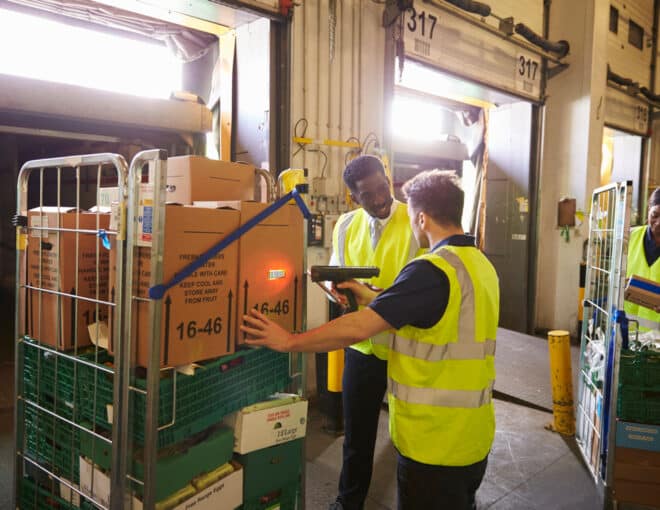
East Coast Port Strike Ends, but Supply Chain Disruptions Persist
By: Wall Street Journal
In the wake of the October 1 ILA dockworker strike, which lasted three days, there are critical operational and strategic insights for shippers, manufacturers, and logistics providers. The strike, though brief, affected nearly half of US ocean imports, disrupting vital supply chains and creating a ripple effect on goods like apparel, automobiles, industrial components, and perishables. Even with a tentative agreement extending the contract through January 2025, it’s important to recognize that strikes of this magnitude can disrupt port operations for weeks, further stressing supply chains already strained by global instability.
The cost of disruption, as seen in this strike, is significant. JP Morgan’s estimate of $5 billion per day underlines the need for businesses to invest in scalable, resilient supply chain solutions that can quickly adapt to fluctuating labor conditions.
CAPSTONE TAKEAWAY
Events like this, even short-lived, can cause significant disruptions and backlogs with compounding impacts. Shippers need a clear plan in place beforehand, and a reliable and responsive partner to support operations during emergencies, to minimize these impacts. Don’t have a plan yet? Check out checklist, based on our experience with situations like this, and review the steps you can take to help you prepare for the next crisis.
USPS Reinstates Holiday Surcharge, Raising Shipper Costs
By: Federal News Network
In 2023, USPS waived its holiday surcharge, aiming to attract more holiday package business with lower prices. However, in 2024, USPS, alongside FedEx and UPS, is reintroducing peak season surcharges, adding further cost burdens to shippers during the critical holiday period. USPS expects to generate an additional $77 million in revenue from these temporary price hikes, but it also anticipates delivering 38 million fewer packages due to the increased costs.
The return of these surcharges underscores a troubling trend — rising last-mile delivery costs, with those charges borne by shippers and consumers. As USPS explained, the surcharges are meant to cover “extra handling costs” during the busy holiday season, with the new prices in effect from October 6, 2024, to January 19, 2025. While these fees are framed as necessary for operational efficiency, they are likely to result in higher shipping expenses for businesses that rely on USPS, FedEx, and UPS for their deliveries.
For a summary of other holiday surcharges, check out Supply Chain Dive’s story on 2024 peak season surcharges: Comparing carrier fees.
CAPSTONE TAKEAWAY
The return of surcharges from USPS, FedEx, and UPS points to additional cost burdens for shippers during peak season. With higher fees across the board, shippers need to look for cost-effective alternatives to the big three carriers in order to stay competitive.
Regional Delivery Service (RDS) providers offer a more economical option. These providers typically do not impose peak season surcharges, making them a less costly alternative. With its expansive regional networks, companies like Capstone Logistics can efficiently handle consolidated, repackaged, and sorted shipments. Their strong presence in urban markets, combined with shipment co-mingling, reduces both shipping costs and transit times, offering shippers a competitive — and often faster — delivery solution during the holiday season.


Addressing the Logistics Labor Shortage: Strategies for Retaining Top Talent
By: SupplyChainBrain
A recent Descartes survey of supply chain and logistics leaders across North America and Europe found that 76% of respondents are experiencing notable workforce shortages in their operations, with 37% characterizing the shortage as high to extreme — a serious obstacle to growth.
This shortage is driven by a mix of factors, including Baby Boomer retirements, reduced immigration, and lower labor force participation, making it hard to find a single solution. For businesses trying to scale during peak seasons, workforce shortages are creating serious challenges with no easy answer. While 54% of companies adjust their strategies, many focus on enhancing recruitment and retention efforts by offering perks such as flexible work hours, higher pay, and career development opportunities.
To counter the labor shortfall, companies are also increasingly turning to automation to reduce the need for manual, repetitive tasks. However, while these technologies can improve efficiency, they are not a complete solution. Supply chain operations remain highly manual, and technology alone cannot replace the need for a capable, skilled workforce to supplement and enhance these systems.
CAPSTONE TAKEAWAY
The most successful organizations are addressing workforce shortages on multiple fronts. Recruiting and retaining top talent is key, as is a strategic use of automation without over-reliance on costly new technology.
Additionally, partnering with warehousing labor specialists is a wise strategy to ensure operational continuity during peak seasons or labor shortages. These partnerships can provide scalable, flexible labor solutions that fill workforce gaps, allow businesses to consistently meet demand, and retain their best employees even under challenging conditions.
Truck Driver Detention: A Growing Industry Challenge
By: Material Handling & Logistics
A recent study by the American Transportation Research Institute (ATRI) highlights that driver detention remains a major issue for the trucking industry, costing billions in lost time and productivity. Despite a slight decrease in detention times in recent years, the total economic impact in 2023 was staggering — $3.6 billion in direct expenses and $11.5 billion in lost productivity. Depending on the industry, drivers were detained for an average of 117 to 209 hours annually, significantly affecting operations and bottom lines across sectors.
Detention issues stem from scheduling problems, inadequate parking and dock space, understaffed facilities, or production delays. In some cases, late driver arrivals caused by external factors such as weather or road conditions may also contribute to inefficiencies.
CAPSTONE TAKEAWAY
Focusing on several key areas can help businesses reduce dwell times and detention costs. Enhancing the inbound flow of materials through advanced visibility tools and technology significantly streamlines operations. Leveraging these tools and aligning dock resources with the specific requirements of incoming freight can efficiently manage the unloading and receiving process.
Additionally, integrating transportation management services with warehouse operations can eliminate the need for comcheck payments, resulting in substantial time and cost savings.
A partnership with an experienced provider that combines warehousing and freight brokerage expertise with proprietary technology ensures the seamless alignment of labor and equipment. This minimizes wait times at the dock, improves throughput, and enhances overall efficiency.








